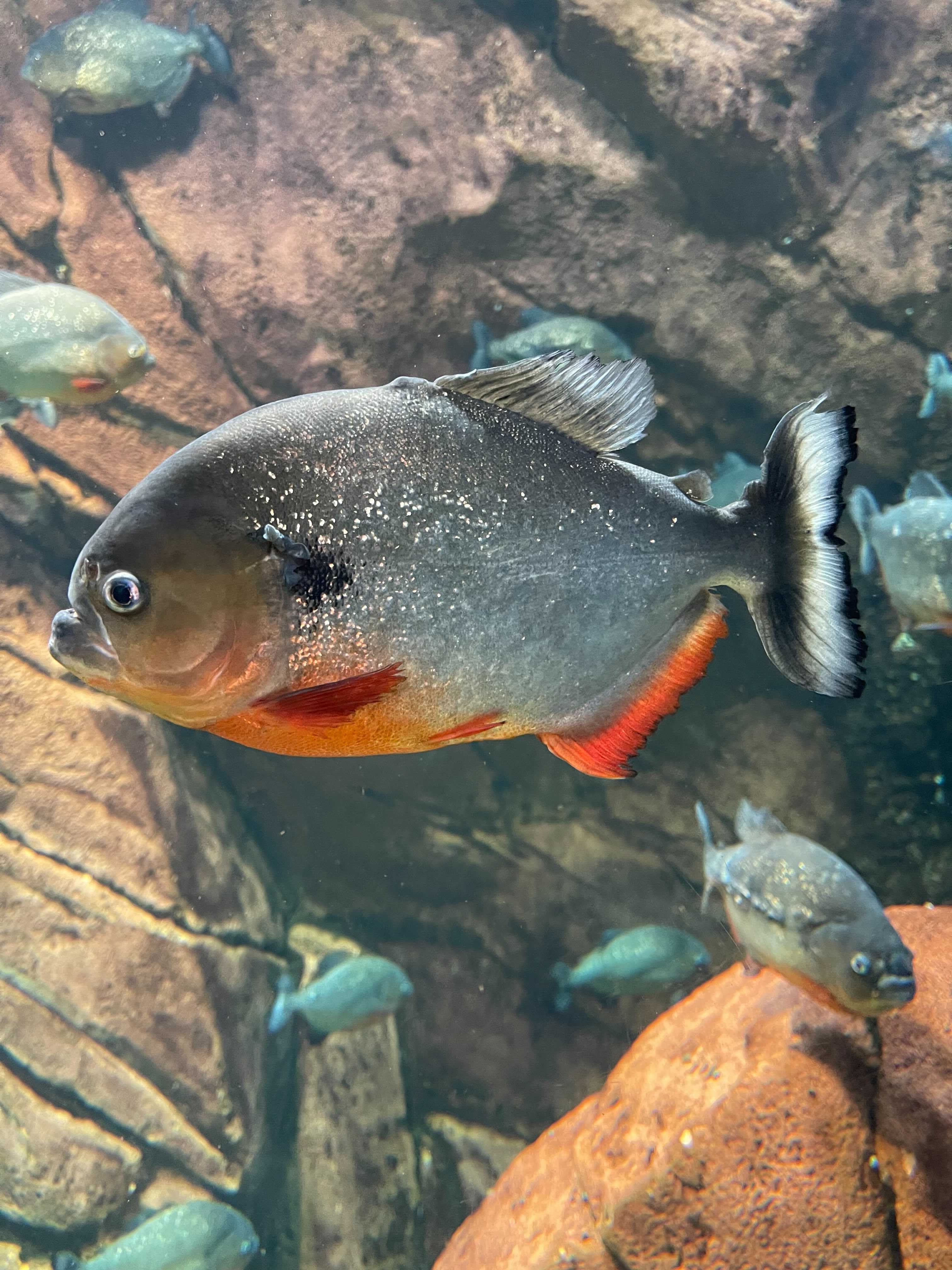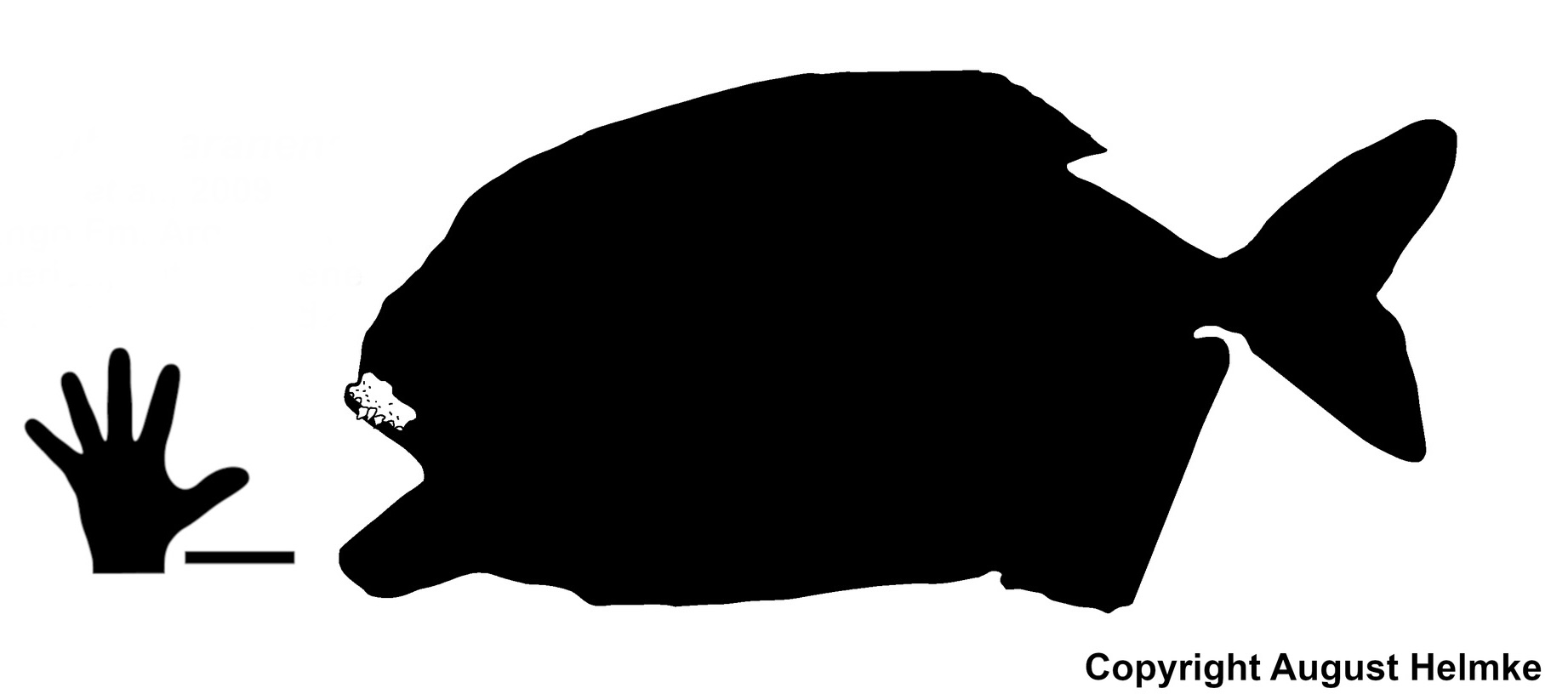|
Piranha
A piranha or piraña (, , or ; or , ) is one of a number of freshwater fish in the family Serrasalmidae, or the subfamily Serrasalminae within the tetra family, Characidae in order Characiformes. These fish inhabit South American rivers, floodplains, lakes and reservoirs. Although often described as extremely predatory and mainly feeding on fish, their dietary habits vary extensively, and they will also take plant material, leading to their classification as omnivorous. Etymology The name originates from the indigenous Tupi people and their respective Tupi language. It is formed from two words, meaning fish and meaning tooth; the same word is used by Indians to describe a pair of scissors. Another possible derivation is from , probably literally "biting-fish". In the mid 18th century the Portuguese merged the word into . Finally, the word may also come from the combination of meaning fish and meaning cut (which also meant "bad" or "devil" in Tupi-Guarani). Taxonomy and ... [...More Info...] [...Related Items...] OR: [Wikipedia] [Google] [Baidu] |
Red-bellied Piranha
The red-bellied piranha, also known as the red piranha (''Pygocentrus nattereri''), is a Type (biology), type of piranha native to South America, found in the Amazon basin, Amazon, Paraguay River, Paraguay, Paraná River, Paraná and Essequibo River, Essequibo basins, as well as coastal rivers of northeastern Brazil.''Pygocentrus nattereri''. Animal Diversity Web. University of Michigan. Accessed 19 February 2016.Froese, R. and D. Pauly, Editors FishBase. 2015. This fish is locally abundant in its freshwater habitat. They are omnivorous foragers and feed on insects, worms, crustaceans, and fish. They are not a migratory species but do travel to seek o ... [...More Info...] [...Related Items...] OR: [Wikipedia] [Google] [Baidu] |
Megapiranha
''Megapiranha'' is an extinct serrasalmid characin fish from the Late Miocene (8–10 million years ago) Ituzaingó Formation of Argentina, described in 2009. The type species is ''M. paranensis''.''Megapiranha'' at Fossilworks.org It is thought to have been about in length and in weight. The consists only of e and a zigzag tooth row; the rest of its body is unknown. [...More Info...] [...Related Items...] OR: [Wikipedia] [Google] [Baidu] |
Pacu
Pacu () is a common name used to refer to several species of omnivorous South American freshwater serrasalmid fish that are related to the piranha. Pacu and piranha do not have similar teeth, the main difference being jaw alignment; piranha have pointed, razor-sharp teeth in a pronounced underbite, whereas pacu have squarer, straighter teeth and a less severe underbite, or a slight overbite. Pacu, unlike piranha, mainly feed on plant material and not flesh or scales. Additionally, the pacu can reach much larger sizes than piranha, at up to in total length and in weight. Name The common name ''pacu'' is generally applied to fish classified under the below listed genera. Among these, several genera contain species where commonly used English names include the word ''pacu'', as listed. *''Colossoma'' – black pacu, black-finned pacu, giant pacu *''Metynnis'' *''Mylesinus'' (''Myloplus'') *''Mylossoma '' *''Ossubtus'' – parrot pacu, eaglebeak pacu *'' Piaractus'' – red-bel ... [...More Info...] [...Related Items...] OR: [Wikipedia] [Google] [Baidu] |
Serrasalmus
''Serrasalmus'' is a genus of piranhas. They are collectively known as pirambebas; the "typical" piranhas like the piraya piranha are nowadays placed in '' Pygocentrus''. Like all piranhas, ''Serrasalmus'' are native to South America. These fish are predatory, have sharp teeth and generally have a rhomboid shape. In some, the shape is more ovoid, particularly in old specimens. Some ''Serrasalmus'' species can exceed (''S. manueli'' and ''S. rhombeus'', according to OPEFE), placing them among the largest Serrasalmidae. Species There are at least 31 recognized species in this genus: * '' Serrasalmus altispinis'' Merckx, Jégu & dos Santos, 2000 * '' Serrasalmus altuvei'' Ramírez, 1965 (''caribe pinche'') * '' Serrasalmus auriventris'' ( Burmeister, 1861) * '' Serrasalmus brandtii'' Lütken, 1875 (white piranha) * '' Serrasalmus compressus'' Jégu, Leão & dos Santos, 1991 * '' Serrasalmus eigenmanni'' Norman, 1929 * '' Serrasalmus elongatus'' Kner, 1858 (slender pira ... [...More Info...] [...Related Items...] OR: [Wikipedia] [Google] [Baidu] |
Serrasalmidae
The Serrasalmidae (serrasalmids) are a family of characiform fishes, recently elevated to family status. It includes more than 90 species. The name means "serrated salmon family", which refers to the serrated keel running along the belly of these fish. Fish classified as Serrasalmidae are also known by these common names: pacu, piranha, and silver dollar. These common names generally designate differing dental characteristics and feeding habits. Description Serrasalmids are medium- to large-sized characiform fishes that reach about long, generally characterized by a deep, laterally compressed body with a series of midventral abdominal spines or scutes, and a long dorsal fin (over 16 rays). Most species also possess an anteriorly directed spine just before the dorsal fin extending from a supraneural bone; exceptions include members of the genera ''Colossoma'', '' Piaractus'', and ''Mylossoma''. Most serrasalmids have about 60 chromosomes, ranging from 54 to 62.''Metynnis'' ... [...More Info...] [...Related Items...] OR: [Wikipedia] [Google] [Baidu] |
Serrasalminae
The Serrasalmidae (serrasalmids) are a family of characiform fishes, recently elevated to family status. It includes more than 90 species. The name means "serrated salmon family", which refers to the serrated keel running along the belly of these fish. Fish classified as Serrasalmidae are also known by these common names: pacu, piranha, and silver dollar. These common names generally designate differing dental characteristics and feeding habits. Description Serrasalmids are medium- to large-sized characiform fishes that reach about long, generally characterized by a deep, laterally compressed body with a series of midventral abdominal spines or scutes, and a long dorsal fin (over 16 rays). Most species also possess an anteriorly directed spine just before the dorsal fin extending from a supraneural bone; exceptions include members of the genera ''Colossoma'', '' Piaractus'', and '' Mylossoma''. Most serrasalmids have about 60 chromosomes, ranging from 54 to 62.''Metynnis'' ... [...More Info...] [...Related Items...] OR: [Wikipedia] [Google] [Baidu] |
Pygocentrus
''Pygocentrus'' is a genus of the piranha family Serrasalmidae. All species are native to tropical and subtropical South America. All the species are predatory, scavengers and may form large schools. The famous red-bellied piranha, ''Pygocentrus nattereri'', is one of four species in the genus. Species There are currently four recognized species in this genus: * ''Pygocentrus cariba'' ( Humboldt, 1821) (black spot piranha) – Orinoco river basin. * ''Pygocentrus nattereri'' Kner, 1858 (red piranha, red-bellied piranha) – Amazon, Paraguay- Paraná-Uruguay, and Essequibo river basins, as well as various river in northeastern Brazil. * '' Pygocentrus palometa'' Valenciennes, 1850 – Orinoco river basin, possibly a nomen dubium.Reis, R. E., S. O. Kullander and C. J. Ferraris, Jr., editors (2003). Check list of the freshwater fishes of South and Central America. CLOFFSCA. EDIPUCRS, Porto Alegre. 2003: i-xi + 1-729 * '' Pygocentrus piraya'' ( G. Cuvier, 1819) (San Francisco piran ... [...More Info...] [...Related Items...] OR: [Wikipedia] [Google] [Baidu] |
Pygopristis
''Pygopristis denticulata'', or the Lobetoothed Piranha is a species of piranha. These fish are part of the group Ostariophysi, a large group of freshwater fish that includes minnows and catfishes. It is a rare South American fish found in the Orinoco River basin, north and eastern Guiana Shield rivers, and tributaries of the lower Amazon River. Piranhas typically live in freshwater, but other specimens can be found elsewhere. Specimens of this species is frequently found in acidic clear or black waters ''Black Waters'' is a 1929 British/American horror sound film produced by Herbert Wilcox and directed by Marshall Neilan. It was the first British-produced talking picture ever shown in England, but it was actually made in Hollywood since that i .... Piranhas are primarily known for being savage, flesh-eating fish, but they actually have broader diets. They usually feed on aquatic insects, small fish, and fruits.Machado-Allison, A. and W. Fink (1996). ''Los Peces Caribes de ... [...More Info...] [...Related Items...] OR: [Wikipedia] [Google] [Baidu] |
Amazon Basin
The Amazon basin is the part of South America drained by the Amazon River and its tributaries. The Amazon drainage basin covers an area of about , or about 35.5 percent of the South American continent. It is located in the countries of Bolivia, Brazil, Colombia, Ecuador, Guyana, Peru, Suriname, and Venezuela. Most of the basin is covered by the Amazon rainforest, also known as Amazonia. With a area of dense tropical forest, this is the largest rainforest in the world. Geography The Amazon River begins in the Andes Mountains at the west of the basin with its main tributary the Marañón River and Apurimac River in Peru. The highest point in the watershed of the Amazon is the second biggest peak of Yerupajá at . With a length of about before it drains into the Atlantic Ocean, it is one of the two longest rivers in the world. A team of scientists has claimed that the Amazon is longer than the Nile, but debate about its exact length continues. The Amazon s ... [...More Info...] [...Related Items...] OR: [Wikipedia] [Google] [Baidu] |
Pristobrycon
''Pristobrycon'' is a genus of piranhas from the Orinoco and Amazon Basins, as well as rivers in the Guianas. ''Pristobrycon'' is not monophyletic. No single morphological feature has been found that completely diagnoses this genus. ''P. striolatus'' is very different from other species of this genus. The genus ''Pristobrycon'' was created by Eigenmann to include species which have intermediate characters between "the fierce ''Rooseveltiella'' ''Pygocentrus nattereri''">Pygocentrus_nattereri.html" ;"title="''Pygocentrus nattereri">''Pygocentrus nattereri''without palatine teeth, and the less blood-thirsty ''Serrasalmus'' with a series of permanent teeth along the palatine". The author designed ''P. calmoni'' as the type species of the genus. Two groups are included in this genus. One group is characterized by presence of the preanal spine (only ''P. calmoni'') and the other group including the rest of the species assigned (''P. careospinus'', ''P. maculipinnis'' and ''P. striol ... [...More Info...] [...Related Items...] OR: [Wikipedia] [Google] [Baidu] |
Fish
Fish are aquatic, craniate, gill-bearing animals that lack limbs with digits. Included in this definition are the living hagfish, lampreys, and cartilaginous and bony fish as well as various extinct related groups. Approximately 95% of living fish species are ray-finned fish, belonging to the class Actinopterygii, with around 99% of those being teleosts. The earliest organisms that can be classified as fish were soft-bodied chordates that first appeared during the Cambrian period. Although they lacked a true spine, they possessed notochords which allowed them to be more agile than their invertebrate counterparts. Fish would continue to evolve through the Paleozoic era, diversifying into a wide variety of forms. Many fish of the Paleozoic developed external armor that protected them from predators. The first fish with jaws appeared in the Silurian period, after which many (such as sharks) became formidable marine predators rather than just the prey of arthropods. ... [...More Info...] [...Related Items...] OR: [Wikipedia] [Google] [Baidu] |
Characidae
Characidae, the characids or characins is a family of freshwater subtropical and tropical fish, belonging to the order Characiformes. The name "characins" is the historical one, but scientists today tend to prefer "characids" to reflect their status as a by and large monophyletic group at family rank. To arrive there, this family has undergone much systematic and taxonomic change. Among those fishes that remain in the Characidae for the time being are the tetras, comprising the very similar genera '' Hemigrammus'' and ''Hyphessobrycon'', as well as a few related forms such as the cave and neon tetras. Fish of this family are important as food and also include popular aquarium fish species. These fish vary in length, though many are less than . One of the smallest species, ''Hyphessobrycon roseus'', grows to a maximum length of 1.9 cm. These fish inhabit a wide range and a variety of habitats. They originate in the Americas, ranging from southwestern Texas and Mexico th ... [...More Info...] [...Related Items...] OR: [Wikipedia] [Google] [Baidu] |






